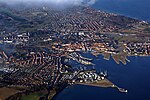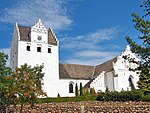Great Belt Bridge rail accident

The Great Belt Bridge rail accident occurred on 2 January 2019 on the Great Belt Fixed Link in Denmark when a passenger train collided with a semi-trailer from or on a passing freight train. The Great Belt Fixed Link is an 18 km (11 mi) long bridge–tunnel connection between the Danish islands of Zealand and Funen, and the accident happened on the West Bridge, near Funen. The accident happened during a storm, which had closed down the bridge for road traffic, but not for rail traffic. Eight passengers were killed, all Danish citizens, and 16 were injured, making it the deadliest rail accident in Denmark since 1988.An early investigation found that in some cases, wagons similar to the one involved in the accident failed to lock the semi-trailers in place. A full investigation was published several months later and it confirmed the earlier results. The Danish Transport Authority temporarily banned this kind of wagon until extra locking procedures were put in place, and have tightened the rules for freight on the bridge during windy weather. Shortly after, temporary measures to avoid similar accidents were introduced throughout Europe and permanent measures will be introduced in early 2020.In January 2021 the use of pocket wagons was again suspended in Denmark, following an incident on the same bridge when a semi-trailer had shifted position, and had protruded beyond the side of its freight wagon.
Excerpt from the Wikipedia article Great Belt Bridge rail accident (License: CC BY-SA 3.0, Authors, Images).Great Belt Bridge rail accident
E 20, Slagelse Municipality
Geographical coordinates (GPS) Address Nearby Places Show on map
Geographical coordinates (GPS)
| Latitude | Longitude |
|---|---|
| N 55.30119 ° | E 10.85988 ° |
Address
E 20
Slagelse Municipality
Region Zealand, Denmark
Open on Google Maps











